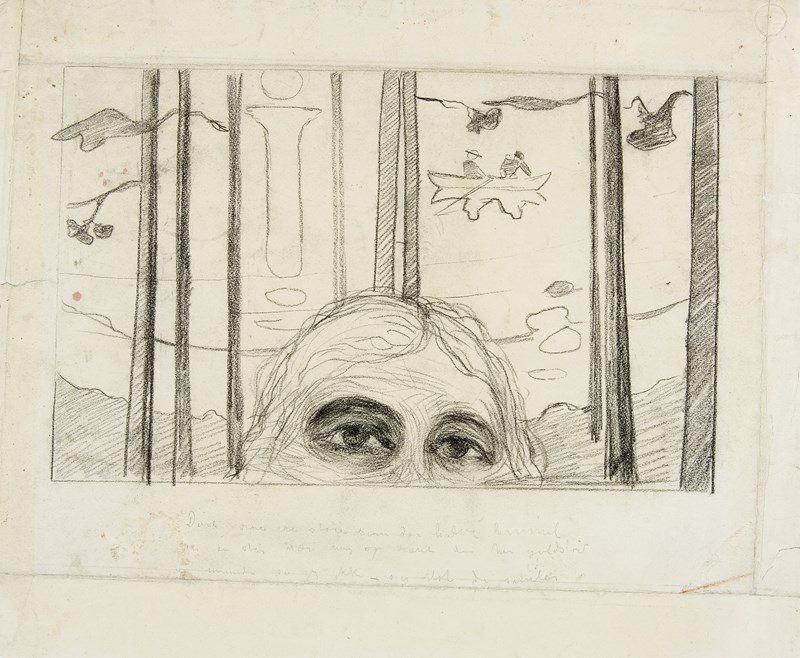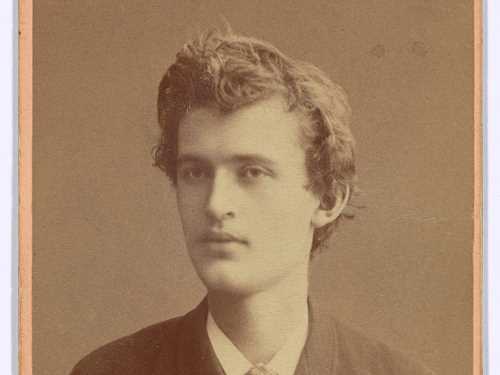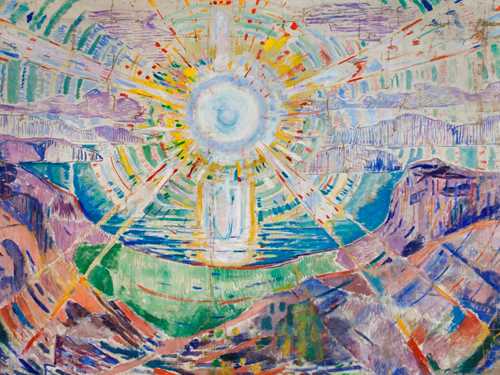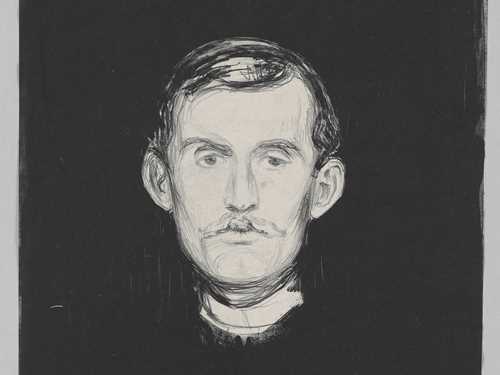About the Project of Digitizing Munch's Drawings
The work on the catalogue raisonné of Edvard Munch’s drawings has been a three-year project, and many professional groups have been involved in the process; paper conservators, librarians, photographers, IT experts, and art historians.

Edvard Munch: Eyes. The Voice. Crayon, black, 1893-96. Photo © Munchmuseet
By: Magne Bruteig
The photographers have been busy taking updated photographs of nearly all the many thousands of drawings in the museum's collection. During the past two years a team of art historians consisting of Magne Bruteig, Frank Høifødt, Petra Pettersen, Sivert Thue, and Gerd Woll have worked continuously on this overwhelmingly voluminous and fascinating art historical material in order to complete this long-awaited catalogue raisonné. In addition, art historian Trine Otte Bak Nielsen has worked for a period on the project, and art history student MaryClaire Pappas has done a great job in creating a survey of privately owned drawings and drawings housed in other public collections. Francesca M. Nichols has translated the titles and texts into English, and the museum's digital collection manager Hilde Bøe has been responsible for transferring all the data from the museum's database to the online catalogue.
Parenthetically: What is a catalogue raisonné?
A catalogue raisonné – or catalogue of artworks – is a complete, illustrated catalogue of an artist's work. In a catalogue of this kind each work is represented with an illustration and title, together with information regarding dating, measurements, technique, medium, registration number, inscriptions, type of motif, exhibition history, provenance and so on.
If the artist's production is great and includes many techniques – as in Munch's case – a catalogue is often published for each of the different techniques. Catalogues raisonnés of Munch's graphic works (2001) and his paintings (2009), together with the digital publication of his writings (2010), represent important milestones in the task of raising interest in, and spreading knowledge about Edvard Munch and his oeuvre. Now at last, all of Munch's drawings are also available online. This is for the benefit and enjoyment of the broader public, while simultaneously serving as a tool for Munch experts around the world. It is the hope of the Munch Museum that this catalogue will lead to increased interest in and further research on this important part of Munch's oeuvre.
More than 90 percent of Munch's drawings are among the Munch Museum's holdings, but the catalogue also presents, as far as has been possible, the drawings from other museums and collections, as well as those in private ownership.
How many drawings?
If you filter your search to show all drawings, 7 645 items appear. There must be 7 645 drawings, you might think. Well, it's not that simple. To begin with, every sketchbook has one “mother entry”, which is not a drawing, the photograph here only shows the cover of the sketchbook. So here we must subtract 201 for the corresponding number of sketchbooks. Simple subtraction. But this is where the problems begin: What is a drawing? Is every mark made on a sheet of paper a drawing? Well, let us consider. In the drawing The Button (MM.T.00226-26) someone is evidently searching for a missing button, but it is hardly likely that six men are searching for the same button. The explanation is that there are six drawings of the same man. And there is a strong resemblance between the six depictions of this man. Can we therefore consider it as one drawing of the same hunt for a button – in six stages? Perhaps. And what about MM.T.00372, where we can distinguish at least ten different drawings, and where most of them do not have any obvious logical connection to each other? Is it one drawing with ten different motifs, or ten separate drawings, which are coincidently located on the same sheet of paper? There is no pat answer to this, yet if one accepts the premise that there can be a number of individual drawings on one sheet of paper, you might easily arrive at over 8 500 drawings, if you sat down to count them. To simplify things we have settled on counting the number of items, rather than drawings.
Another problem in connection with the question “what is a drawing?” is the distinction between a drawing and a doodle, a pattern, a diagram, etc. Here we have had to rely on our judgement. Our intention was to include even very simple, unpretentious and unfinished drawings, because they fill in the picture of how the drawing process progressed for Munch. Nevertheless, after a round of discussions, we have raised the bar a little as to what we felt was worthy of a place in the catalogue. MM.T.00134-04 is actually below the limit of what we wished to include. The same applies to the drawing on the next page of the sketchbook, MM.T.00134-05. But when the drawing following that one – MM.T.00134-06 – turns out to be a combination of the two previous drawings, they become interesting as documentation of a process. They have therefore escaped from being stricken from the list.
But what about a drawing that the artist has crossed out – and thereby “censored” himself? In some cases, the crossing out is so dense that it is barely possible to see what lies under it. These we have obviously not included in the selection. In other cases, the motif is quite distinct, as in Crossed-out Reclining Female Nude, MM.T.00991. Although Munch was obviously not satisfied with the drawing, we have chosen to include it. The crossing out becomes a fascinating addition to the drawing itself: why has he crossed out this one in particular? There are many less successful drawings that are not crossed out. Was he in a bad mood – had the model irritated him? There was a similar case in the world of music a few years back; the sheet music for Edvard Grieg's Symphony in C Minor were inscribed with the words, “Not to be performed”. Despite this, in 1981 the Moscow Symphony Orchestra chose to perform it, 74 years after the composer's death. Now, 72 years after Munch's death, we are making public some of his crossed-out drawings.
The progression of the work
The first phase of this process was to register all the drawings anew. Both the museum's drawings and many of those outside the museum had already been registered, but it was necessary to go through every single drawing once more, to verify and supplement the existing information. Among other things, in addition to the height and width, we measured the thickness of the paper used, in order to more easily locate different drawings on identical paper. This information can be useful in dating the drawings, especially when an unusual type of paper is involved. In the process of this registration, misleading or inaccurate titles were corrected, the dating was evaluated and temporarily established, the type of drawing tool used (pen, brush, pencil, crayon, pastel) was noted, the signature and inscriptions were verified and/or recorded, and the type of paper evaluated. In addition, references to comparable works were added, including drawings, prints and paintings; and the type of motif was noted (landscape, portrait, nude, interior, etc. – with subgroups). In the online catalogue, comparable works will show up in a small format under the main entry, and the type of motif for each drawing exists as buttons you can click on to access all the other drawings that are registered with the same type of motif. This will be of invaluable help for users of the online catalogue.
The comprehensive and time-consuming registration was followed by a phase that included quality control, an expansion of related works and a special focus on the dating.
Dating the works
Dating Munch's paintings and graphic works can be challenging enough. But then again, we have a good number of dates that were noted by Munch himself, many works that have been included in documented exhibitions, and other relatively certain reference points. When it comes to the drawings one has very little to go by. Barely more than a few per cent are dated by the artist, and although Munch exhibited drawings relatively often, they were rarely documented in the exhibition lists or via photographs. In addition to purely stylistic evaluations, we have therefore made use of a rather broad range of “pegs” that together have led to certain, or probable, datings for well over 90% of the drawings. Admittedly, they are not always honed into one specific year, but often within a five-year period. All of the datings are accompanied by the supplementary categories “certain”, “probable” or “uncertain”, so that the user can see which category the individual drawings belong to. Now which are the “pegs” we have used?
Here are some of the most important:
- We have searched for connections to other drawings, graphic works or paintings. Precedence was given to comparable works with verified datings. The drawing Two Women by the Veranda Stairs (MM.T.02795-047-verso) is quite obviously a sketch for the painting with the same name (MM.M.00623 (Woll M 1775)). Since this has a certain dating at 1942, we are on safe ground when we apply the same date to the drawing.
- The reason the above-mentioned painting has been given a certain dating is because one of the two women has been identified as Dorothy Drewry, who modelled for Munch in 1942, and that year only. And this brings us to another “peg”: in cases where we know the model or the person whose portrait has been drawn, we can often pinpoint the execution to a specific period in time, at best to a specific year, as in the above case. In other cases, the time period might be rather broad: Hildur Christensen was Munch's model – and housekeeper – from 1923 to 1933, so here one must draw on other “pegs” in order, if possible, to narrow down the dating even further.
- Determining the location can sometimes also give relatively certain datings. For instance, Munch visited Åndalsnes only once, in 1925, so MM.T.01479, Åndalsnes and Nesaksla, and other drawings from the same place can be safely fixed at this year.
- We have already mentioned the role of the paper quality. Munch often used quite ordinary paper, which does not give us many clues to go on for dating. Yet in periods he employed types of paper that were so special that if we find many drawings on the same type of paper, it can give a clear indication of when they were executed. Paper with watermarks can be particularly useful. The drawing MM.T.02064 has clear similarities to the motif The Wedding of the Bohemian and has traditionally been dated at 1925–30, like the paintings MM.M.00473 (Woll M 1524) and MM.M.00218 (Woll M 1526). However, the drawing is stamped with the watermark “Buskerud Bank”, which is otherwise only found on stationery used by Munch in letters from 1937 (probable dating) and 1939 (certain dating). This evidence is further strengthened by the written address, “Kirkeveien 106”, an apartment building that was completed in 1936. MM.T.02064 is therefore not a preliminary sketch for The Wedding of the Bohemian, as previously assumed, but a later replication, and hence the dating was set at 1936–40 (probable). We have made special note of the paper manufacturer J. Whatman, who included the production year in their watermarks. It appears as though Munch purchased a quantity of this type of paper a number of years in a row, and the probable dating of these drawings are the production year and a few years after.
- Munch's texts, which in transcription comprise approximately 13 000 pages, can also provide useful information regarding dating, through descriptions of travels, events and people. The digital catalogue raisonné of texts at emunch.no has made it easy to perform targeted searches for specific information.
- Munch worked on some motifs only during limited periods. Among others, this applied to commissions that he received, or hoped to receive, such as the decorations for the University of Oslo ceremonial hall (the Aula), the decorations for the Freia Chocolate Factory, and the drafts for the Bergen Stock Exchange and Oslo City Hall. The depiction of his eye affliction in 1930 is another special series of motifs.
- The sketchbooks form a category apart, with many different possibilities for determining the time of their origin. Most of them were filled with drawings within a relatively short period of time, often during the course of one or a few years. Hence, if one can find a certain or probable dating for one or more of the drawings, it is reasonable to assume that the others have a corresponding dating. However, Munch has obviously taken up some of the sketchbooks again after many years and drawn further in them, so each book had to be evaluated meticulously. The sketchbooks were often also used as notebooks, and include lengthy accounts and text fragments, the names of people, places and hotels, addresses and telephone numbers, etc. The possibilities for searching historical sources are many: for both names and addresses we have for instance searched digitised historical directories for Kristiania/Oslo in order, if possible, to find out when the person in question lived at the given address.
- Among other relevant historical sources are photographs. We were at first unable to identify the building in MM.T.01239. A request to the Facebook group “Gamle bilder fra Oslo” (“Old pictures from Oslo”) provided an immediate answer: it was the rear façade of the Parliament building (Stortinget), as it appeared before the annex facing Akersgata was erected in 1958. Through further examinations of such details as lamp posts, stone walls and the height of trees in photographs of the area behind the Parliament from ca. 1880 to ca. 1920, we arrived at a probable dating at around 1905. The gathering of people in the drawing may well be related to the Parliament's deliberations regarding Norway's secession from Sweden that year.
In addition to these and other “pegs” is stylistic analysis, of course. In his youth in particular, Munch went through evident developmental stages as a draughtsman that are possible to pinpoint with a large degree of precision. He eventually developed a broad repertoire of drawing techniques, however, which he could shift between, depending on what he found most relevant to the motif, drawing tools, and so on. In such cases it is more difficult to say anything certain about the dating based on the style. In the last decades of his life he developed a characteristically loose, short-hand style, in particular in the pen drawings. Cf. for example Rising from the Chair, MM.T.02296.
Work on the dating of the drawings is not simply a vast canvas to be bleached; it is a canvas that will never be conclusively bleached. New information will most certainly appear, and new evaluations will be made that will change the datings of many of them in the years to come. Nevertheless, we feel that through a systematic and concerted review that focuses not only on individual works, but on Munch's entire production of drawings, we have contributed to significantly elevating the quality of the dating of this extremely comprehensive material.
Titles
The titles of a great majority of the drawings were originally a form of working titles, given by different people in different periods. The manner in which they were fixed therefore often seemed accidental and unsystematic. And, unlike the paintings and prints, the drawings have practically no references that might indicate which titles Munch gave them in his exhibitions. So with the exception of a very few examples where he has inscribed a title – or something that may be interpreted as a title – on the drawing itself, we have no idea what he called them. We have nevertheless made an effort to implement a number of guidelines to create a minimum of structure and continuity in the titles.
Among the most important are:
- We wished to affix simple, neutral and descriptive titles to the drawings. MM.T.00201-04 has thus been given the title Man with a Package under His Arm. Here we have chosen to highlight two elements; the fact that it is a man, and the detail that best distinguishes the drawing from others, i.e. the package under his arm. “Standing Man with Overcoat and Cap and Package under His Arm” would also be a neutral and descriptive title, but not particularly simple.
- The many nudes included in this material have been given the general titles Male Nude or Female Nude. In the past the majority of the female nudes were simply called Nude, while the male nudes were specified by gender. We have chosen to give the genders equal place here. A nude is defined as a specific type of studio drawing, and that is why the title of MM.T.01691 has been changed from Female Nude Sitting on Bare Rocks to Naked Woman Sitting on Bare Rocks.
- The genre type “Portrait” is not used in titles when the person is identified, only the name of the individual, as in Jappe Nilssen. “Portrait” may be used in reference to unidentified persons if there are clear individualised features, as in MM.T.00153-16 Portrait of a Girl.
- In drawings related to Henrik Ibsen's plays, the play's title is placed first, as in MM.T.00211-26 The Pretenders: The Final Hour.
- When a known motif is included in the title, this is placed in quotation marks: MM.T.00382-recto, Two Sketches for “Vampire”.
- Alma Mater / The Researchers: Alma Mater was the Aula motif that caused Munch the most trouble. Briefly put, Alma Mater and The Researchers are the same motif, but the latter has the added depiction of a group of children on the beach, who are studying objects they have found – hence representing researchers of the future. In order to emphasise the common traits between the two motifs, we have chosen to call the drawings that include the children on the beach The Researchers. Alma Mater, while the drawings without them are simply called Alma Mater.
- “Sketch” is a relatively flexible term, and anyone browsing here will probably find a number of inconsistencies. It is used to describe a number of drawings that clearly precede a known motif, often a painting, as the above-mentioned Sketch for “Vampire”. Other drawings with this motif might, on the other hand, just have the title Vampire. In that case they should generally have a more independent character, but the boundaries here are difficult to draw. “Sketch” has also been used to indicate that the drawing is unfinished, as in MM.T.00118-26-verso, Unfinished Sketch of a Pocket Watch.
Comments
Supplementary texts are linked to some of the drawings. These might include comments regarding the dating, the motif, travels that Munch was on when he executed the drawings, or other subjects. These texts are penned by five of the art historians behind the work on the catalogue and are signed with the initials: (FH) Frank Høifødt, (GW) Gerd Woll, (MB) Magne Bruteig, (PP) Petra Pettersen, and (ST) Sivert Thue.
In conclusion
Edvard Munch's drawings encompass a voluminous and multifarious material that is not easy to get an overview of. But by being a team that has worked intensely with all aspects of the material, and contemplated it from various angles, we have been able to find and develop links between individual works as well as various parts of the whole. Discussions along the way have also helped us to arrive at results which we could hardly have achieved separately. We hope this online catalogue will be a source of pleasure to a broad public that will now have the opportunity to become acquainted with a large and important – and previously somewhat hidden – part of Munch's oeuvre, and be useful to researchers and anyone else with a special interest in Munch's drawings and the important function they had for the artist Edvard Munch.



